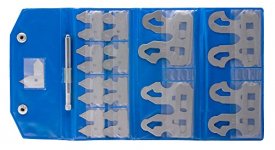Hi Kristian:
There are a few things you can do to improve your success.
The first and most important is to split up the offsets so you can manipulate them independently and sneak up onto the diameter offset first and the height offset second.
The way to do that is to program the path with G41 or G42 so you can manipulate the effective tip diameter with a wear offset in the control:
Program your path with the nominal tip diameter and add 0.005" of stock allowance to the nominal path but with G41 (or G42 if you want to conventional mill rather than climb mill).
Now run your cutter well above it's final height so only the tip cuts.
Changing the compensation value in the control, you can run around the path until the tip is cutting just a twitch deeper than you want, then back the comp value off to where it was "just right".
This allows you to get within tenths with perfect control.
Now you can do the same again with the Z level; setting the diameter offset so only the very edge of the biggest diameter of the cutter is cutting, and drop down in Z until again your cutter is cutting just too deep and then back off one increment.
Now you can simply re-set your diameter offset and you're good to go; that particular cutter is dialled in.
All of your test cuts will blend in because they were all done in the waste stock, so even the trials where you overshot a bit will clean up perfectly.
That's why you ran the cutter above the proper height for the first offset settings and at a bigger diameter for the second offset settings.
There are a few other things you can do too, to help achieve success.
If your need is primarily cosmetic and not geometric fidelity, you can modify the cutter slightly.
If you stone both ends of the radius on each flute just a twitch, the cutter will become less sensitive to precise positioning and will still make a good-looking radius.
This can be helpful if your top surface is not perfectly flat.
Similarly you can grind a tiny bevel at the corners of the cutter so long as you make its angle very shallow and blend it perfectly with the radius so it's accurately tangent to the rad.
You can also get a nicer cosmetic result if you play the cutter up a thou and out a thou compared to where it should be in a theoretically ideal world: your geometry will be incorrect but often it'll make no functional difference, however the work will look much nicer.
The best way, is to abandon the form cutter all together and learn to 3D surface those features instead of form cutting them.
When you
must make time on the job, a form cutter is a lot faster, but when you
must have the best looking outcome, surface milling them will give the nicer result by far.
I use 3D Contour or Flow or Scallop (I'm running HSMWorks) depending on the geometry and all do a much better looking job than a formcutter can ever hope to do, but they take a LONG time by comparison.
So that's it in a nutshell; try all the techniques out, see which one suits your job best and give 'er a go!
Cheers
Marcus
Implant Mechanix • Design & Innovation > HOME
Vancouver Wire EDM -- Wire EDM Machining




